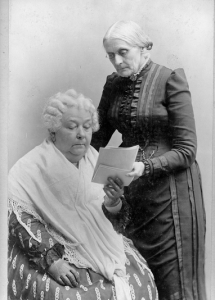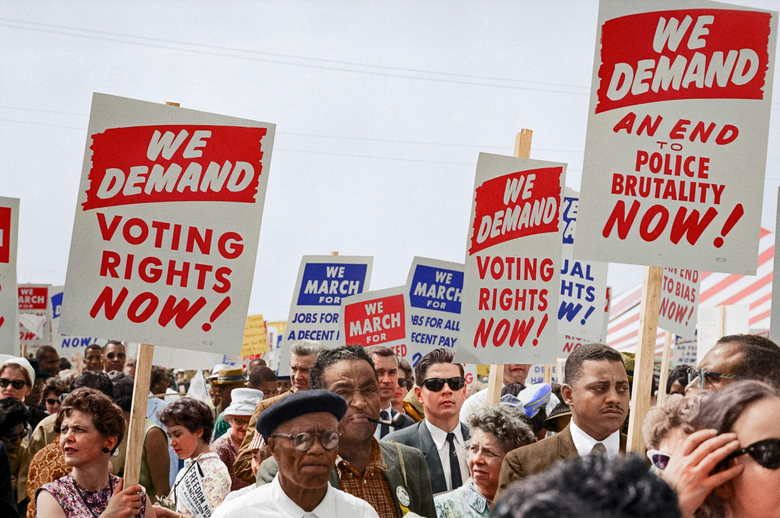By Mohammed Nurhussein
Photos: Library Of Congress\Facebook
The patriarchal puritanical society of the United States as in much of the Western world in the 20th Century often relegated women to inferior status subservient to the will of their male counterparts. Their achievements have gone for the most part unrecognized, their roles in many of the pivotal events downplayed or not sufficiently acknowledged.

It took for instance decades of mass protests for the right to vote, a struggle that culminated in Congress finally passing the 19th amendment that was ratified on August 18/2020.
We know the leading role played by Susan B Anthony (above right) and Elizabeth Stanton (above left) in the suffrage movement but how many of us know about the Black and Native American suffragists who were doubly oppressed and had to wage a civil rights campaign as people of color and as women. The indomitable Ida B. Wells was not only a prominent campaigner against lynching but also a major suffragist. Sojourner Truth and Harriet Tubman also played major role in the suffrage movement. Among Native Americans one may include Mary Louise Bottineau Baldwin and Suzette La Fleche Tibbles (Bright Eyes) who were campaigners for Native American rights as well as suffragists.
As the Women’s History month winds down, I would like to focus on three remarkable women who by their transformative actions changed the course of American History.
As much as I am a believer in the Woodson notion of history that believes people, and not individuals make history, these three women make me wonder if I should modify my thinking as they do not quite fit the mold.
One of them is the fearless Black civil and labor rights activist and organizer, the second one is a white labor rights activist and policy maker and the third one is a Black teenager who defied the system in Jim Crow South and was written out of history until her biography over a decade ago resurrected her from total oblivion.
Ella Baker was born in 1903 in Norfolk, Virginia. She was a class valedictorian when she graduated Shaw University in 1927. She soon started her political activism in the midst of the Depression by organizing the Negroes’ Cooperative League, long before cooperatives became fashionable in the 1960s. As a field secretary for the NAACP she traveled through Jim Crow South recruiting members. She left the NAACP for its lack of grass roots organizing that she advocated.
After the Greensboro lunch counter protests by Black students, she invited them and other student groups to a meeting at Shaw University, delivered her ‘Bigger than a Hamburger’ speech and helped them organize the Students Nonviolent Coordinating Committee (SNCC) mentoring the likes of Julien Bond, Stokely Carmichael and Diane Nash. Dr. King wanted SNCC to be the youth wing of the SCLC but Ella told the young activists to keep their independence and militancy. One of her mentees, Bernice Johnson Reagon, founder of the acclaimed Sweet Honey and the Rock band, was later to dedicate Ella’s Song to her mentor. Ella Baker was on the staff of the loosely associated movement of church leaders later becoming the Southern Christian leadership Conference but left decrying the one man leadership style of the organization preferring the group leadership or ‘servant leadership’ of SNCC she helped form. She has been in the midst of many of the important events of the 1960s and 1970s-whether it was the founding of a socialist movement (the Mass Party Organizing Committee), supporting Puerto Rican Independence Movement or forming the Freedom Democratic Party. She was an active campaigner against Apartheid and the Free Angela campaign.
Her political and social activism spanning six decades brought her in contact with W.E Dubois, A Phillip Randolph, Martin Luther King Jr., Bayard Rustin, Thurgood Marshall and the young leaders in SNCC, among others. She fought racism in the society and sexism within many of the civil rights movements and was vocal in her condemnation of both.
Her biographer called her perhaps the most influential woman in the civil rights movement and one of the most important Americans of the 20th Century. Her contribution to the civil rights movement and other progressive causes is immense and impactful, in many ways greater by the variety of causes she espoused over a longer period than that of her male contemporaries, many of whom we have come to admire and celebrate.
She died in 1986. There are no streets, public institutions except one school that carry her name. There is no Ella Baker Day to memorialize her. About time a grateful nation recognized her as the towering figure she was.
Frances Perkins is the other woman whose accomplishments in the area of labor rights eclipse all others, man or woman.
Born to a conservative Catholic Boston family, she moved to Philadelphia where she found a job investigating phony employment agencies that were exploiting immigrant women. She got a firsthand look at the system of exploitation. She enrolled at the University of Pennsylvania, Wharton School to enhance her education.
She moved to NY and became a passionate advocate of labor rights, campaigning for the elimination of child labor. She got her degree in political science at Columbia U.
One fateful day on March 25/1911 she witnessed the Triangle Shirtwaist Factory go up in flames at which 146 workers lost their lives some of them jumping out of the window to their death. Some say the New Deal was born on that day.
The then governor of NY, Franklin D. Roosevelt appointed her as the Industrial Commissioner of the state of NY. When the stock market crashed she went to Great Britain to study how that country managed its unemployed. The idea of workers compensation germinated.
FDR called her to Washington when he was elected president and offered her the labor cabinet as his secretary. She put a set of demands as condition for her acceptance. Some of them included the Social security, minimum wage, workers safety, Workman compensation, disability insurance etc. all of which FDR accepted. The New Deal was thus her creation with a willing president helping to implement it. Programs she pushed through Congress were nonexistent and unthinkable in those days. It would be unthinkable now to do without those programs that have served Americans well for close to a century. She retired from government becoming the longest serving Secretary of Labor. She moved to NY to join the NY School of Industrial and Labor Relations at Cornel U until her death in 1965. We are in awe of her accomplishments and lifelong dedication to labor rights and social justice.
The third woman in this triumvirate may not have the long list of achievements of the previous two but her action at age 15 was just as impactful in rocking the very foundation of Jim Crow in Alabama. Her name is Claudette Colvin. She refused to leave a seat reserved for whites at a Montgomery City bus on March 2, 1955. This happened 9 months before Rosa Parks did the same. Claudette was a young bright student who was exposed to a bit of Black history of resistance by one of her teachers. Claudette was arrested for breaking the unjust Jim Crow laws of segregation. She was one of 4 plaintiffs that brought suit against the Montgomery Bus Company. The courts ruled the practice unconstitutional a year later. The defiant action by this teenager was shunned by the civil rights leaders at the SCLC who felt that she was not mature enough, presentable enough and refined enough to be palatable to their white supporters and was practically erased from history until her biography came out in 2009 (Claudette Colvin-Twice Towards Justice by Phillip Hoose)
She lived a life of obscurity working as Nurse Aide in the Bronx until the publication came out and she received a late life recognition and fame.
In her biography, asked why she did not leave her seat she explained it eloquently and movingly in these words. “I could not move, because history had me glued to the seat. . . It felt like Sojourner Truth’s hands were pushing me down on one shoulder and Harriet Tubman’s hands were pushing me down on another shoulder, and I could not move”. It says it all.
These are three women of different backgrounds and life experiences, yet share a passion and commitment to justice, civil and labor rights and decided to do something about it. What they did was transformative, historic and consequential impacting our lives for the better. The nation ought to honor these valiant women with a meaningful recognition and memorialization and not wait to embrace them until a movie comes out as was done with “Hidden Figures”.
All Glory to them.

Mohammed A Nurhussein MD










